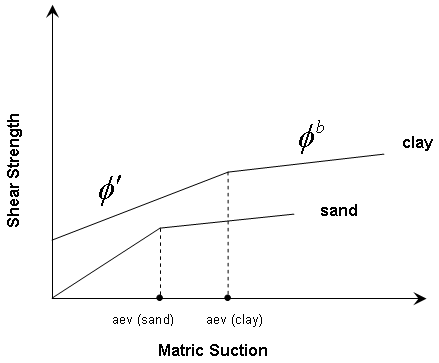Unsaturated Shear Strength
The Unsaturated Shear Strength option in the Define Material Properties dialog allows you to account for shear strength induced by negative pore pressures (commonly referred to as matric suction) in the unsaturated zone above the water table. Unsaturated shear strength parameters are Phi_b and Air Entry Value, as described below.
Negative pore pressures can result from:
- Finite element groundwater analysis (either steady-state or transient)
- Water pressure grid interpolation
- Water tables or piezo lines (negative pore pressures are automatically computed above the water surface)
For any of the above groundwater methods:
- If negative pore pressures are calculated AND
- You define unsaturated shear strength parameters,
then materials in the unsaturated zone above the water table, will exhibit additional shear strength due to matric suction as described below.
Unsaturated Shear Strength Angle (Phi_b)
By specifying an Unsaturated Shear Strength Angle (Phi_b) for a material, the shear strength of the material in the unsaturated zone will be INCREASED by the amount:
![]()
 = matric suction (POSITIVE value), and
= matric suction (POSITIVE value), and  = unsaturated shear strength angle. (NOTE: by convention, the term matric "suction" implies the POSITIVE, or absolute value of the negative pore pressures calculated in the unsaturated zone.)
= unsaturated shear strength angle. (NOTE: by convention, the term matric "suction" implies the POSITIVE, or absolute value of the negative pore pressures calculated in the unsaturated zone.)By default, the Unsaturated Shear Strength Angle = 0. This means that matric suction in the unsaturated zone, WILL NOT have any effect on the shear strength or safety factor. If you enter a non-zero value for Unsaturated Shear Strength, then slip surfaces which pass through a material in the unsaturated zone, will have INCREASED shear strength, and safety factor.
The Unsaturated Shear Strength Angle is usually not a well-known quantity. To obtain an appreciation of its importance, a parametric study can be carried out, in which the Unsaturated Shear Strength Angle is varied between 0 and the Friction Angle of the material. This can be easily accomplished using the Sensitivity Analysis capability of Slide2.
USE WATER CONTENT FUNCTION TO DETERMINE PHI B
When you turn on a transient analysis, there is an option in the material properties dialog for unsaturated shear strength “Use water content function to determine Phi b”. This uses the method in:
Vanapalli, S. K., et al. "Model for the prediction of shear strength with respect to soil suction." Canadian geotechnical journal 33.3 (1996): 379-392.
Using the relation in equation 17:

to determine the increase in shear strength in the unsaturated zone using the water content as a function of matric suction.
You need to do a transient analysis because the strength is a function of water content and volumetric water content in the unsaturated zone is only computed during a transient analysis.
Air Entry Value
Air Entry Value is defined in Fredlund and Rahardjo (1993) as the matric suction value that must be exceeded before air recedes into the soil pores. The Air Entry Value is also referred to as the "displacement pressure" in petroleum engineering or the "bubbling pressure" in ceramics engineering.
In terms of strength, it is the point at which the strength of the soil deviates from its saturated effective Mohr-Coulomb behavior. If matric suctions exceed the air entry value, the strength is assumed to follow a linear envelope with Phi_b as the friction angle. Thus Slide2 uses a bilinear strength envelope where:
- c' and phi' are used with positive pore pressures, and with negative pore pressures (matric suction) up to the air entry value
- Phi_b is used when negative pore pressure exceeds the air entry value.
The following figure (after Fredlund (2000) ) illustrates the effect of the air entry value. For matric suction below the air entry value, the saturated effective stress friction angle is used. For matric suction greater than the air entry value, the unsaturated shear strength angle, Phi_b is used.
Effect of air entry value (aev) on unsaturated shear strength envelopes

Negative Pore Pressure Cutoff
If you are using Unsaturated Shear Strength parameters for a material, the Negative Pore Pressure Cutoff option allows you to limit the contribution of negative pore pressure to the material shear strength. This option is in Project Settings > Groundwater.